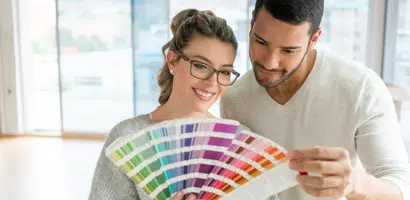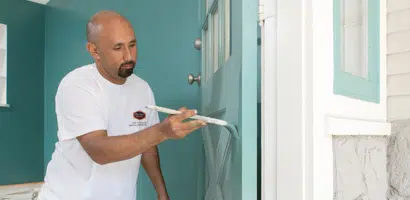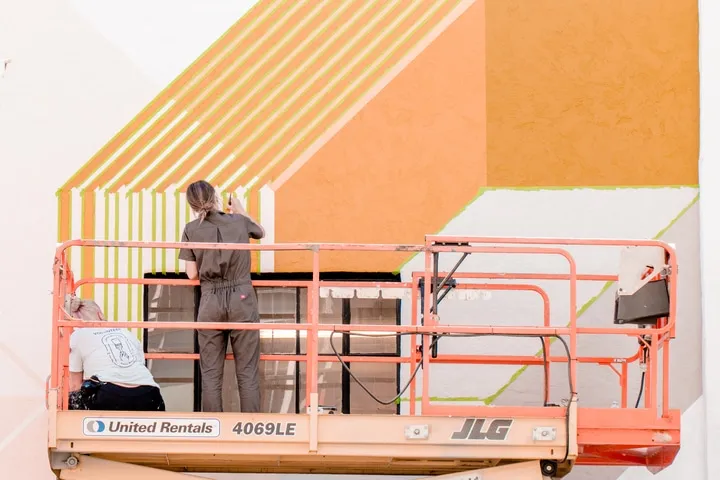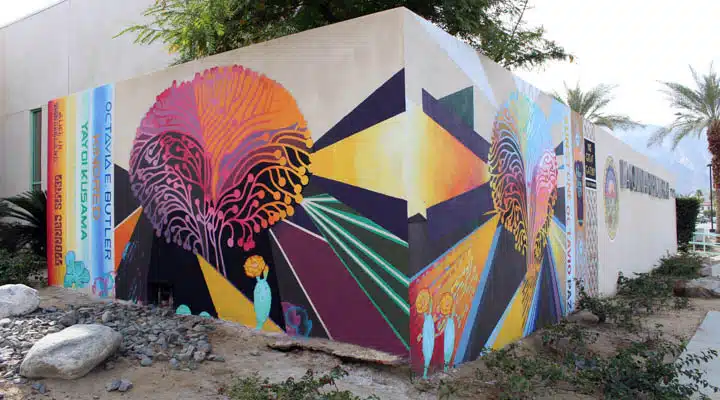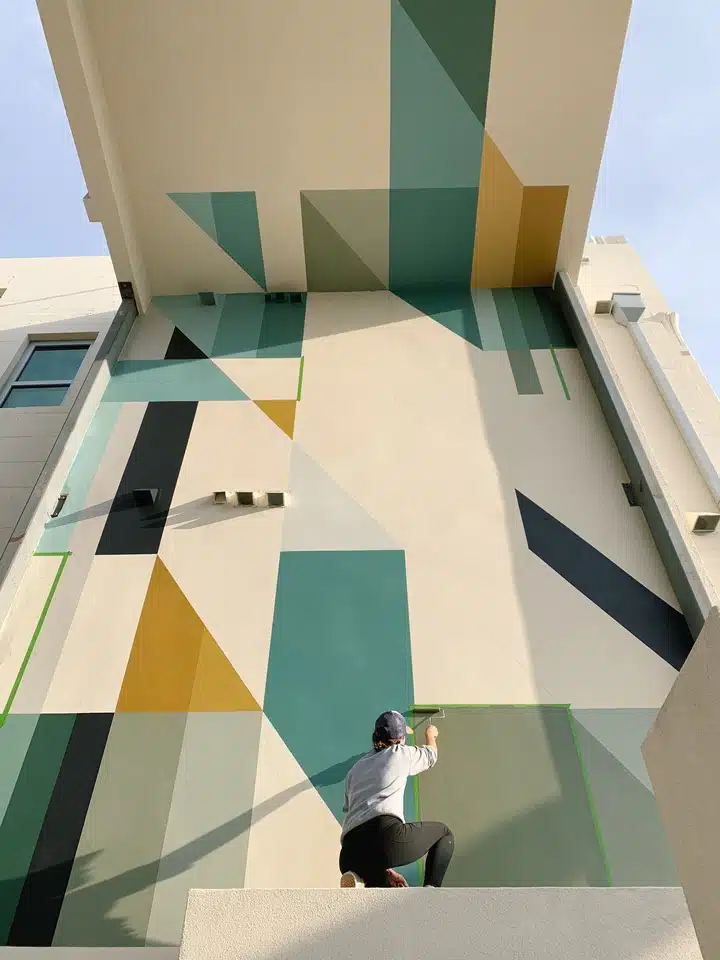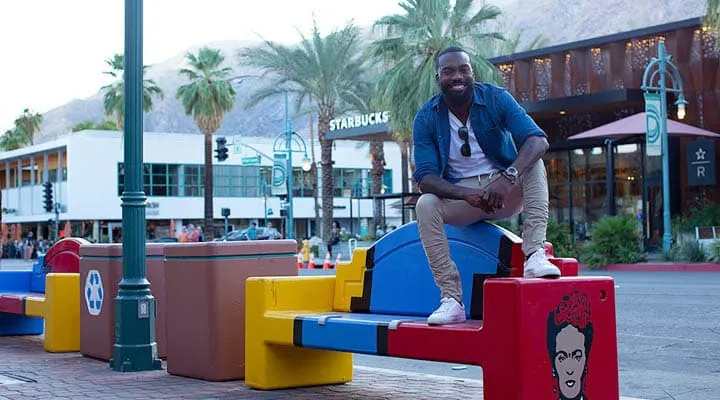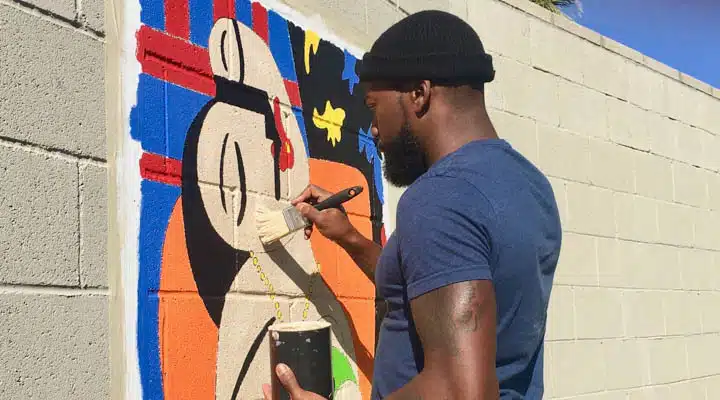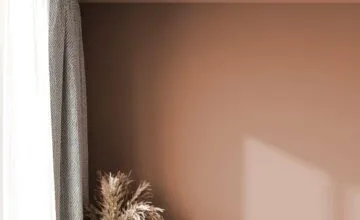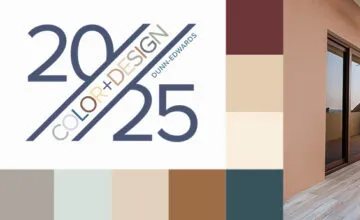These Favorite SoCal Muralists Share Their Top Painting Tips
02/22/2022 | Marni Mervis |
At Dunn-Edwards we know the impact a brilliantly colored commercial exterior or interior focal wall can have. In fact, oftentimes the right answer to businesses is a mural and curating the right color and design can generate a following of fans for a business. So we’re checking back in with some of our favorite muralists previously featured on the Dunn-Edwards design blog to get their tips and tricks to create a lasting, large-scale creative work.
Rochford working on her mural for Ladies Who Paint mural festival. Courtesy of Janie Rochfort.
Texture is Key
Likely no two walls you encounter will ever be exactly the same. That’s why understanding how different textures and materials interact with your paint is key to executing a standout mural. “Paint coverage per square foot can widely vary depending on the surface,” says Janie Rochfort of multi-disciplinary design studio, Betty Larkin. A smoother surface will require less coverage and therefore less paint, while a rougher one can require much more paint. And a material like wood, can be the trickiest of them all. In fact, Coachella Valley muralist, John Cuevas, explains that, “wood is the most difficult substrate to work on because it expands and contracts with temperature and humidity.” He notes the secret to working with a material such as this is to identify any weak points in it first and ensure those are brought up to par. “The key is to look for any areas that can be exposed to rain, or more likely in California, air conditioning condensation drains and prime those areas extensively and seal them.”
Cuevas’ mural “Volta" located outside the La Quinta Public Library. Courtesy of John Cuevas.
Learn To Go From Concept to Reality
When it comes to commissioned murals, most design concepts are a collaboration between artist and client. So how does this concept go from idea to reality on a large-scale wall? Each artist may approach this slightly differently. Some may love math and convert scale and sketch a design out on their own, while others prefer technology and programs like Photoshop and AutoCAD to help them perfect layout, elevations, and scale, ultimately using that image as a guide. Even for smaller interior mural projects like this craft studio, attention to detail is key to perfect execution. San Diego-based Rochfort, who often creates murals for restaurants and office spaces, prefers to take the technology one step further if the conditions are right, “If I’m lucky, I can project the artwork onto the wall to sketch over, which saves a ton of time.”
Rochfort painting one of her murals. Courtesy of Janie Rochfort.
Plan, Plan, Plan
Painting amid the elements and the public means there are always factors out of the artists’ control. This is why planning for every imaginable scenario can help muralists mitigate delays. Scenarios like extreme weather can often be a problem for muralists in southern California as was the case for art education non-profit Off The Wall and their mural covering the exterior of Zane Grey High School in Reseda, Calif. Palm Springs' muralist Tysen Knight is no stranger to scorching temperatures. “I have done murals in 123 degrees,” he says. In those scenarios, “tents and plenty of fluids are essential.” But ordinarily, Knight prefers to plan around the extreme weather in advance, often painting early in the mornings or late at night to get the best outcome.
Knight, one some of his work for the Palm Springs Public Art Commission. Courtesy of Tysen Knight
Trust Your Vision
It might seem obvious, but there’s no hiding a mural. Public art is well, public and of course invites public discourse. Ultimately, it's this public discourse and immediate feedback which makes the work of muralists so exciting. “Painting a mural is like being a musician playing a live set in a small club. You can hear everyone and their reactions,” explains Cuevas, who has created works from shopping malls, to nightclubs, and breweries throughout the desert cities.
The energy and the fun of it all is something Knight, who is known for his pop art style, echoes, noting that the most important thing is to have fun with one’s murals and leave a piece of one’s essence in every project. Trusting in that essence, or signature style, means knowing that as an artist you’ve stayed true to yourself. And for Betty Larkin’s Rochfort it’s this assurance which has helped her come to terms with the fact that at the end of the day you can’t please everyone and that’s ok.
Work With The Experts
Each muralist has their own style and their own process but most can agree on one thing—when it comes to paint, they always work with the experts. “Whenever I start a project the first thing I do is look for the nearest Dunn-Edwards store. The employees are paint experts,” says Cuevas.
Whether a muralist is trying to match a new mural’s sheen to a space’s existing interior paint, or searching for the best paint for a particular exterior substrate, every mural is different and as a result, can call for a different paint product. When it comes to exterior projects for example, Knight needs paint that can protect his art against harsh Palm Springs sun, “outside murals need high-quality UV exterior paint, Dunn-Edwards paint is my number one choice for all my mural projects.”
Knight working under the desert sun. Courtesy Tysen Knight.
For more mural inspiration, check out these Ladies Who Paint and see how multimedia artist James Stanford drew from fantastical themes and Sin City’s storied history to create this massive mural in downtown Las Vegas.
Featured Articles
-
Best Oranges for the Perfect Summer Beach Cottage
-
Get Ready for Fall with These Trendy Color + Design Moods
-
Try These Color Palettes To Nail A Tomato Girl Summer At Home
-
Embracing Barbiecore: Popular Pinks Throughout The Ages
-
The Color Yellow: Essential Color Theory, Symbolism and Design Application






